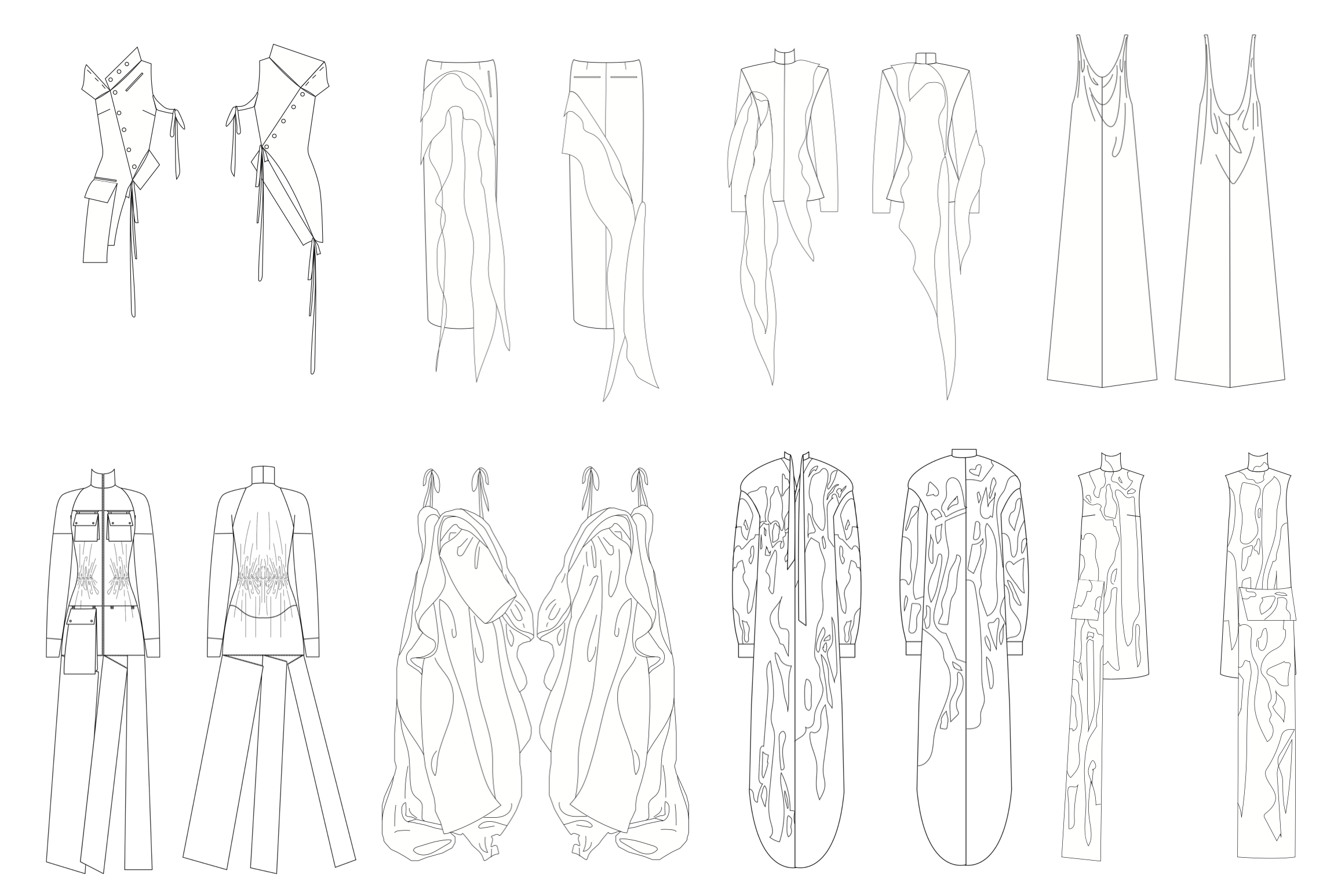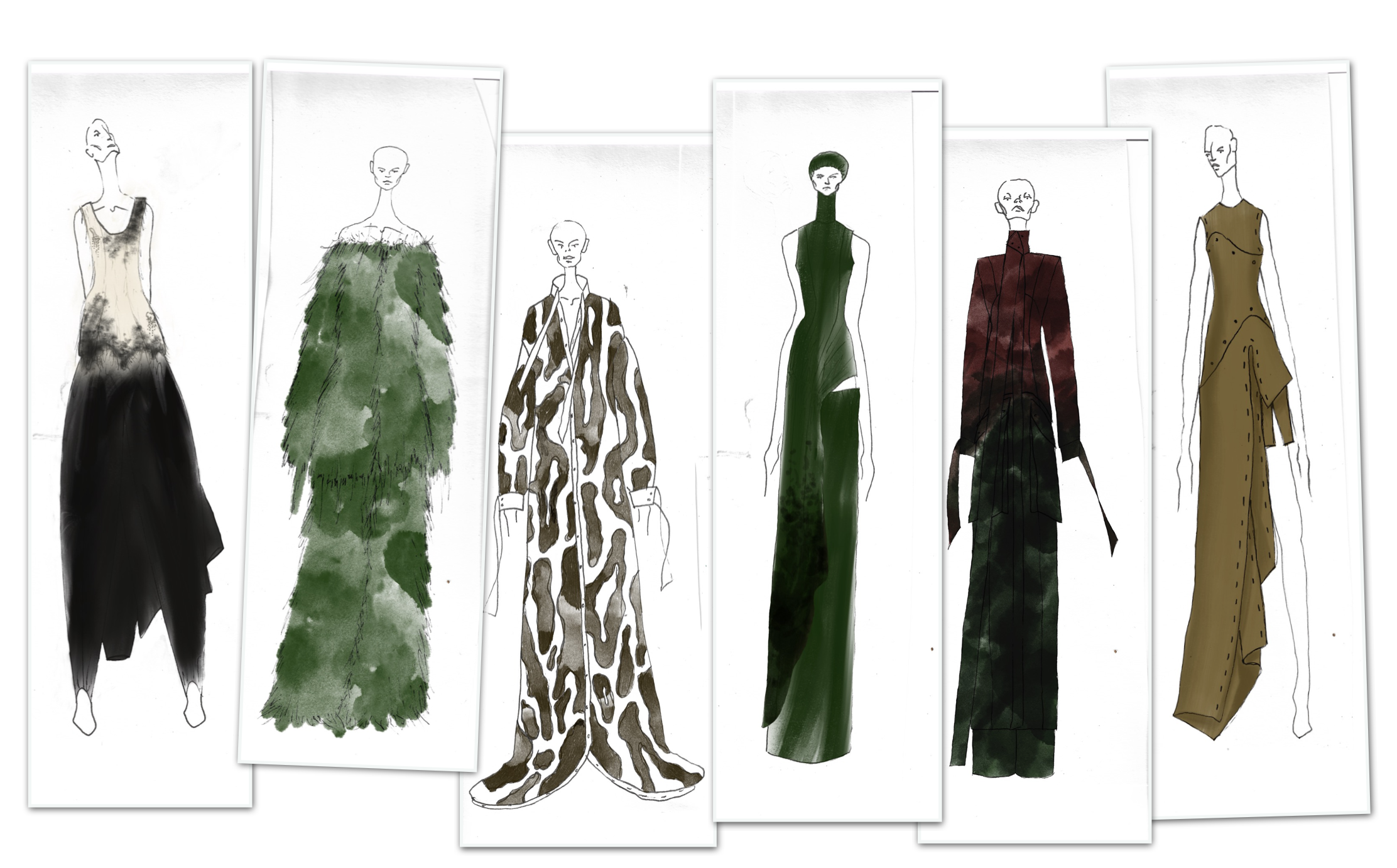
The Defamation of Karen Blixen
“An exploration into the historical use of hunting culture within Britain as a means of solidifying Aristocratic power through macabre tradition.”
This collection is intended as a continuation of the themes explored in my project “morbid curiosity” which focused on humanity’s obsession with the grotesque and the anatomical exploration of the macabre through hunting and dissection - shifting focus from the hunted to the hunter.
For centuries, the British aristocracy have used hunting as a tool to display power and solidify class divides. Over the years, the wealthy have taken what was before seen as an activity breed from necessity, into an unnecessary and elaborate display of outdated tradition. This cling to tradition, and the power it conveys, is most prevalently seen in the early 1900’s with the accessibility of photography and other medias highlighting the lavish lifestyles of the upper class, bred from colonialism, on hunting parties in south Asia and Africa, with the killing of “big game” in these locations being seen as the height of power and extravagance. However, one thing I noticed about many of these hunting parties was the absence of these upper class individuals when it came to the preparation of the animals after the morbid grandeur of the event had surpassed, the skinning and deconstruction of the carcass would be removed from view of the individual who carried out the killing. Rather, they would simply shoot the animal, take a photograph, return to their manors and palaces upon which the beast would be displayed in the form of taxidermy, both on the wall and in the centre of elaborate dinning settings. It’s this removal and naivety of the realities of these archaic “traditions” as a means of retaining the dwindling generationally acquired power that I really wanted to centralise my research and development on.
My initial development took inspiration from Denis Villeneuve’s short film “next Floor”, capturing the greed and grotesque power of many of the aristocracy; imagery of decay, outdated forms of glamour from the turn of the century and morbid platters of raw and preserved animals, both traditional and exotic, stuck out to me as key signifiers of this attachment to tradition and prestige. After this initial research, I found myself infatuated with the specific clothing associated with hunting culture from Edwardian Britain to modern day, analysing the different interpretations of outdoor wear from formal hunting jackets and apron skirts of the early 1900’s, to loose waterproofs and removable legs of tactical trousers associated with modern day practicality. It was important for me to explore this evolution and and societal shift of practicality; as well as what is, and what was, considered appropriate attire for hunting as well as other broad interpretations of outdoor wear. This idea of the clothing developing and adapting continually thanks to societies advancements culturally and technologically, while the activity it is being used for remaining stagnant is something I wanted to directly combat, and abstract through merging silhouette, functionality and ideals of past and present interpretations of formality and practicality in an outdoor setting, specifically that of a hunting party. This exploration resulted in a collection of convertible and transformable pieces with the dichotomy between formal and practical being at the forefront of my design.
My final source of inspiration came when considering how this gradual loss of power has affected the traditionally ostentatious lives of the aristocracy. With this loss of power over the last century specifically, it is commonly known that the generational wealth and assets passed down from parent to child, and subsequent expectation of old money austerity, have gradually broken down and decayed as a result of neglect and inability to retain the upkeep necessary to sustain these now outdated lifestyles. Which of course, has become physically evident in the erosion and decomposition of not only their stately homes, but also expensive and exclusive textile. Exotic fur, leather and tweeds have been lost to time and neglect, these pieces that were once symbols of wealth and glamour at the turn of the century have now lost their perceived perfection, and as a result are seen as useless to the upper classes, with this ideal of perfection being the key principle of these traditionally upper class lives which, ironically, are the quickest features of these lifestyles to dissipate over time. To convey this ideal of decay and imperfection, I looked into the preservation techniques of ancient textile, such as the “Tarkhan Dress” on display at the UCL Petrie museum, this research led me to employing the techniques of using and replicating degrading and faux animal textiles, such as exotic leather and hide, as a means of subverting the expectations and perfection associated with the original use of these macabre textiles and referencing their historical resonance, in a modern world.
Final Outcome
“With these pieces, I really wanted to reflect the melding of opulence and utility as well as ornamentation and degradation. The idea of an aristocrat shooting an animal on a hunt, then transitioning to a formal dinner with that same beast being presented before them, all while wearing the same hunting gear. At its core, these looks aim to reflect the transformational properties necessary for such a lavish, macabre lifestyle that is the British aristocracy.”
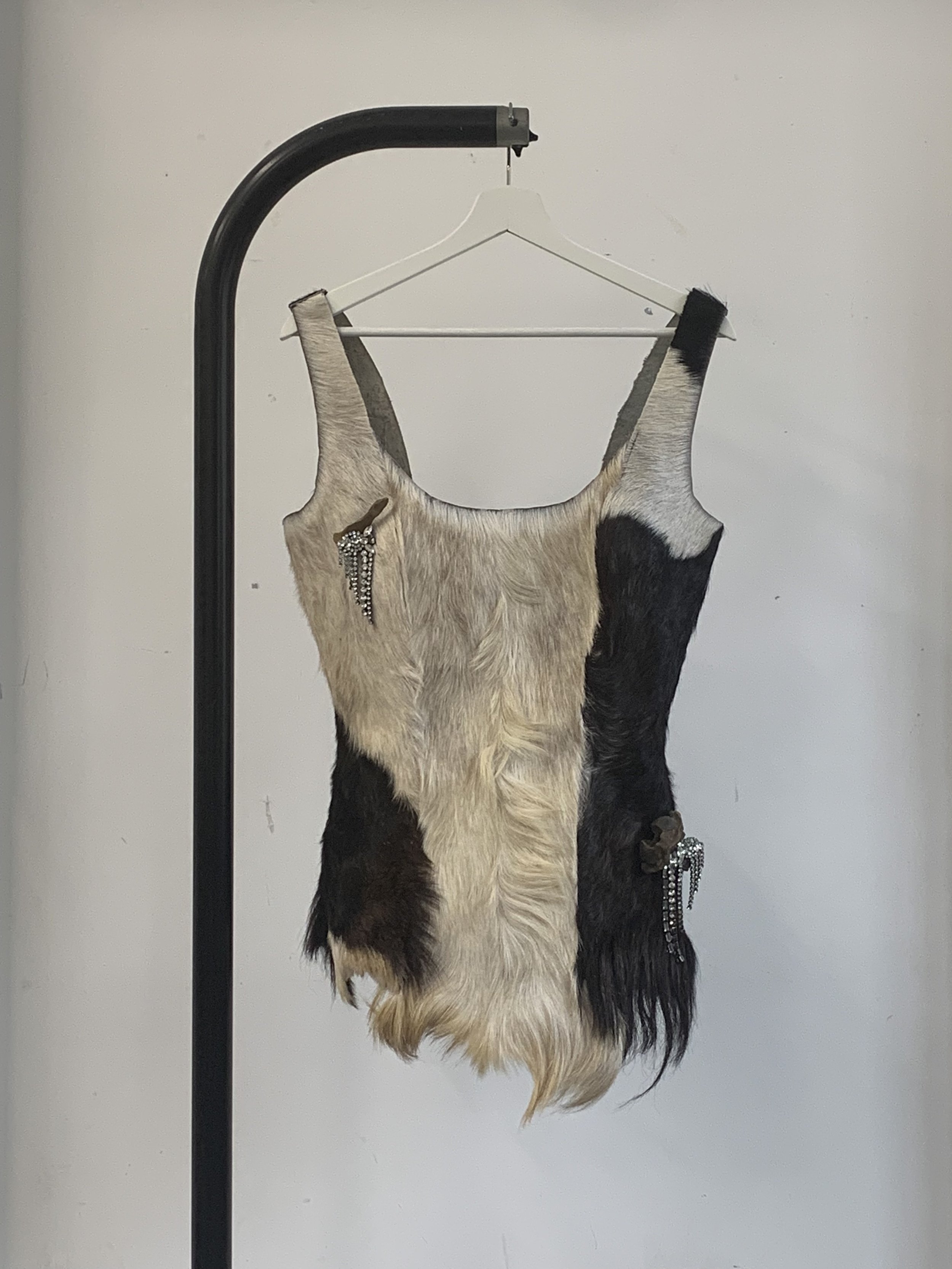
Primarily centred around the ideal of grotesque ornamentation, this bodice utilises degraded goat hide deemed unfit for commercial use. Recontextualised here in a tank style bodice to enhance its natural flaws, and subsequently shed a light on the perfectionism and waste generated by the rich and their desire for absolute aesthetic perfection. The bodice also features custom broach style embellishments made from vintage, jewellery and discarded animal bones, found on the shores of the thames, further reflecting that ideal of grotesque ornamentation.
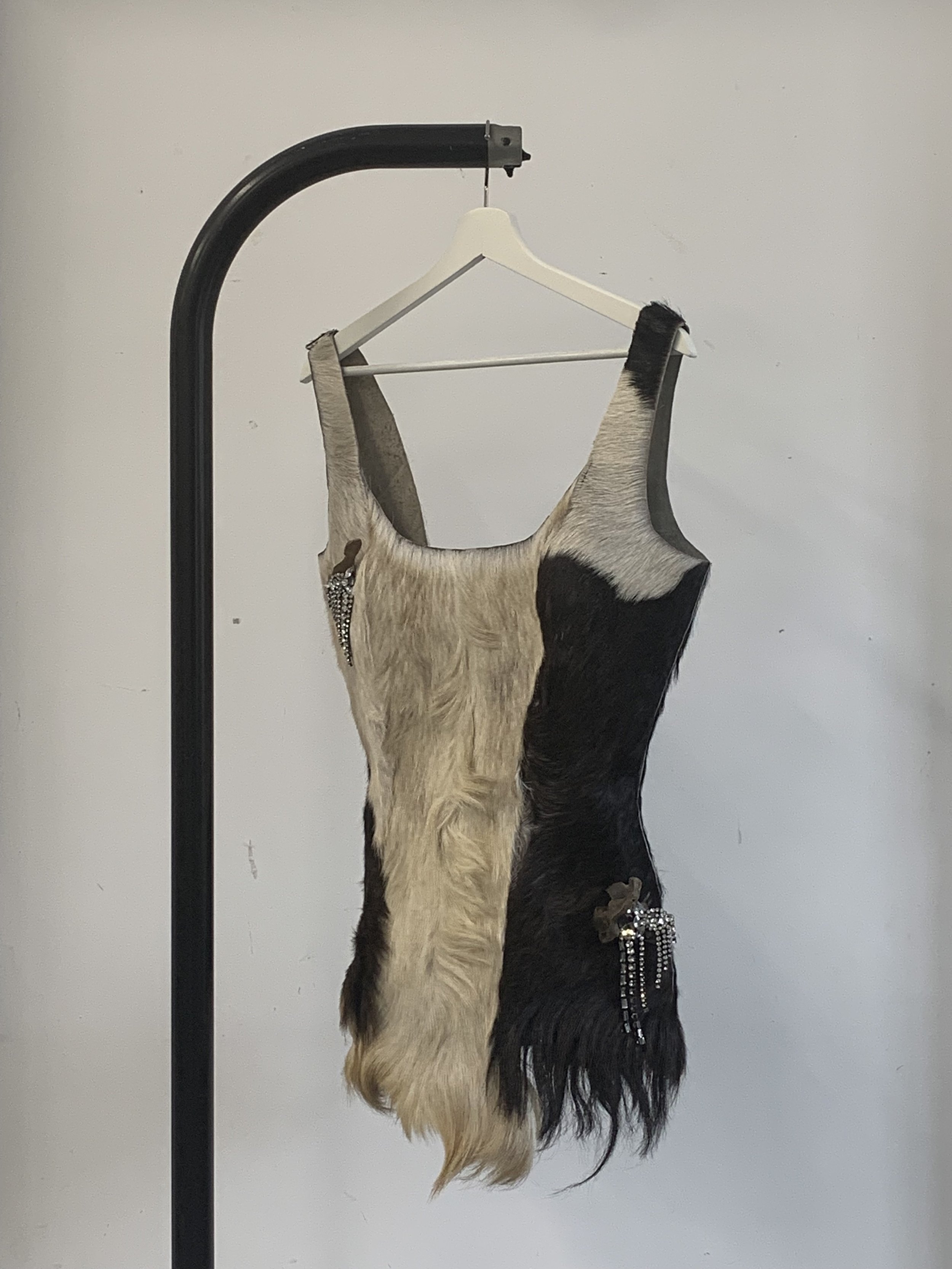
Primarily centred around the ideal of grotesque ornamentation, this bodice utilises degraded goat hide deemed unfit for commercial use. Recontextualised here in a tank style bodice to enhance its natural flaws, and subsequently shed a light on the perfectionism and waste generated by the rich and their desire for absolute aesthetic perfection. The bodice also features custom broach style embellishments made from vintage, jewellery and discarded animal bones, found on the shores of the thames, further reflecting that ideal of grotesque ornamentation.
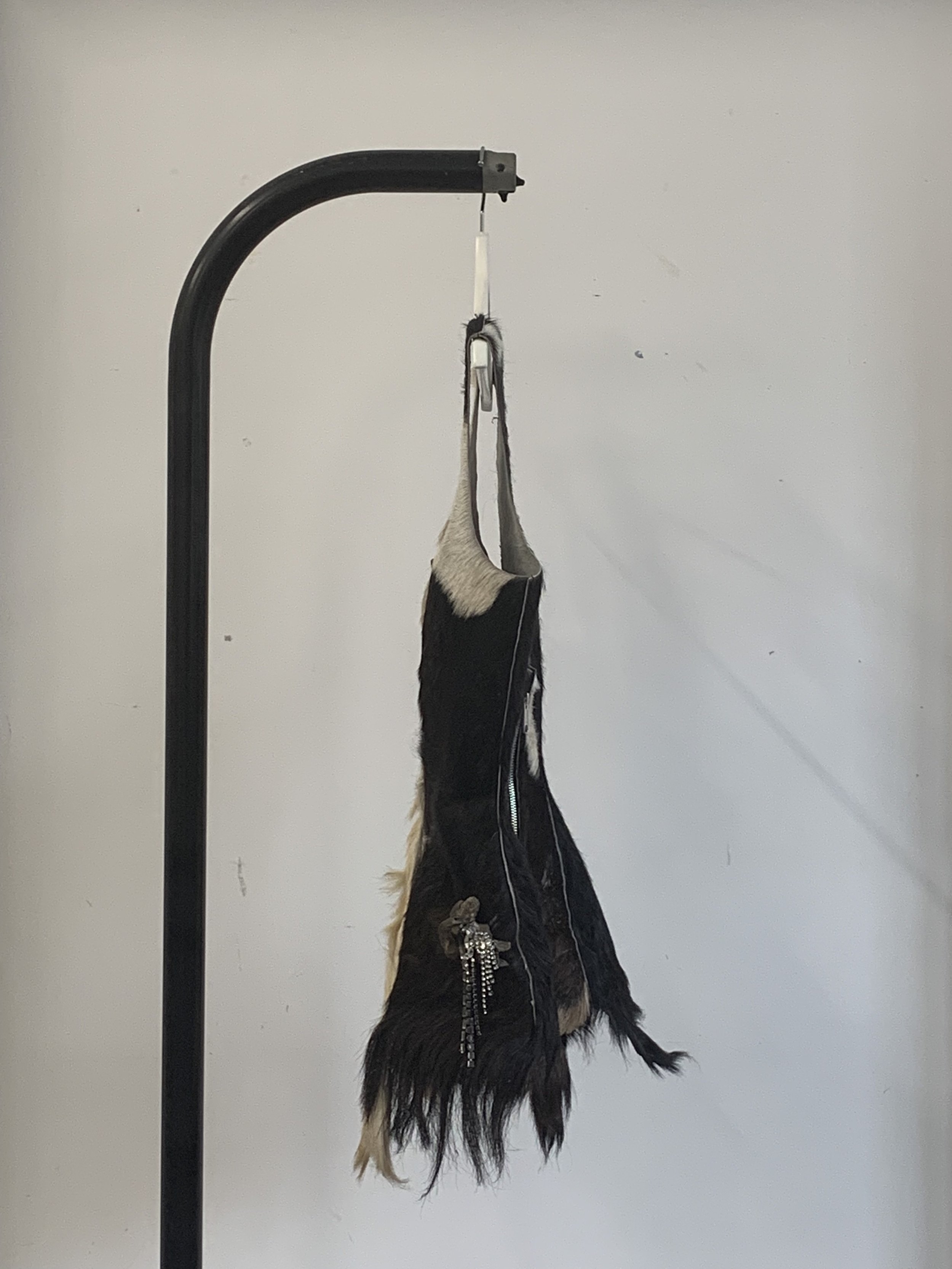
Primarily centred around the ideal of grotesque ornamentation, this bodice utilises degraded goat hide deemed unfit for commercial use. Recontextualised here in a tank style bodice to enhance its natural flaws, and subsequently shed a light on the perfectionism and waste generated by the rich and their desire for absolute aesthetic perfection. The bodice also features custom broach style embellishments made from vintage, jewellery and discarded animal bones, found on the shores of the thames, further reflecting that ideal of grotesque ornamentation.
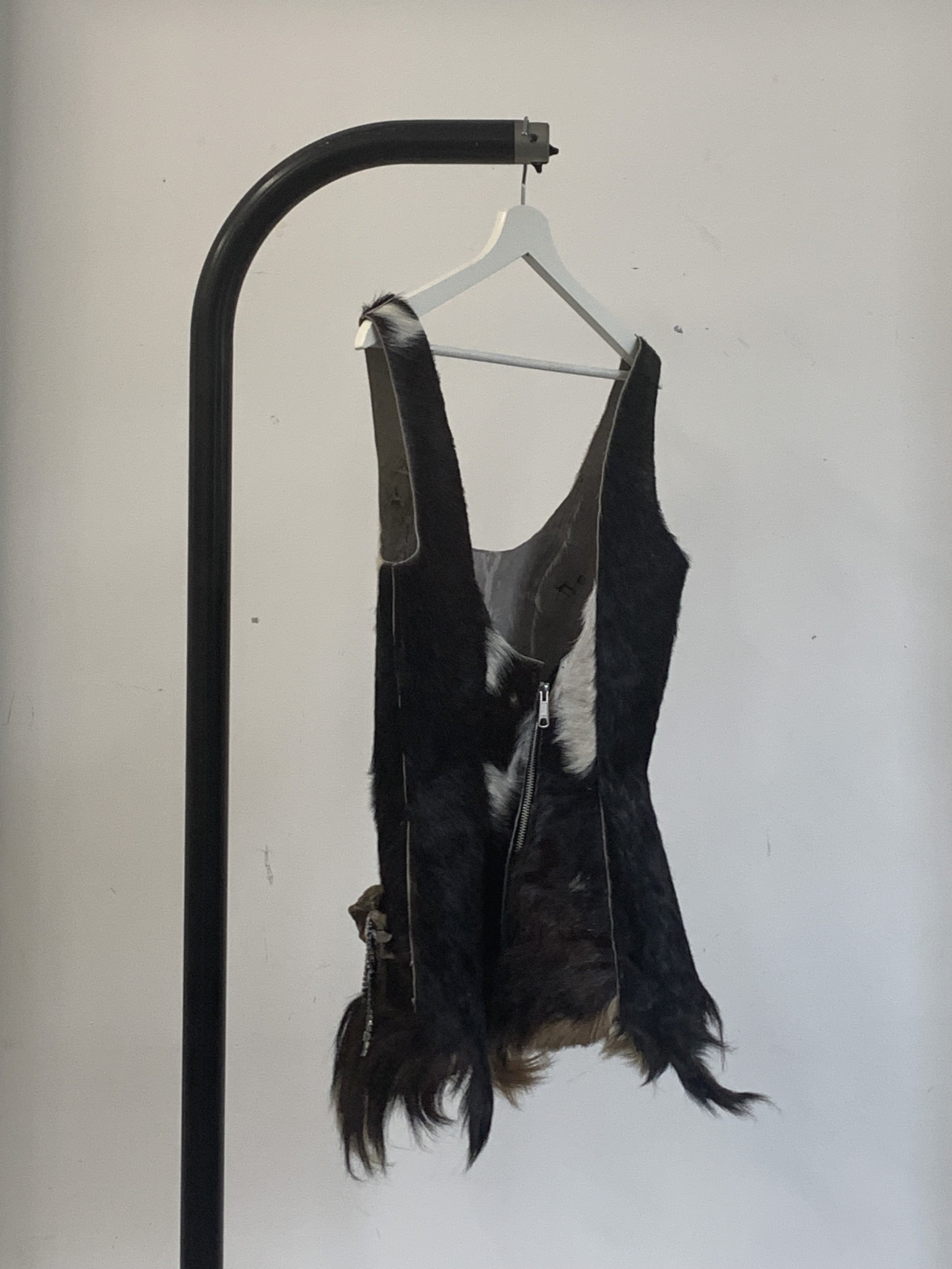
Primarily centred around the ideal of grotesque ornamentation, this bodice utilises degraded goat hide deemed unfit for commercial use. Recontextualised here in a tank style bodice to enhance its natural flaws, and subsequently shed a light on the perfectionism and waste generated by the rich and their desire for absolute aesthetic perfection. The bodice also features custom broach style embellishments made from vintage, jewellery and discarded animal bones, found on the shores of the thames, further reflecting that ideal of grotesque ornamentation.
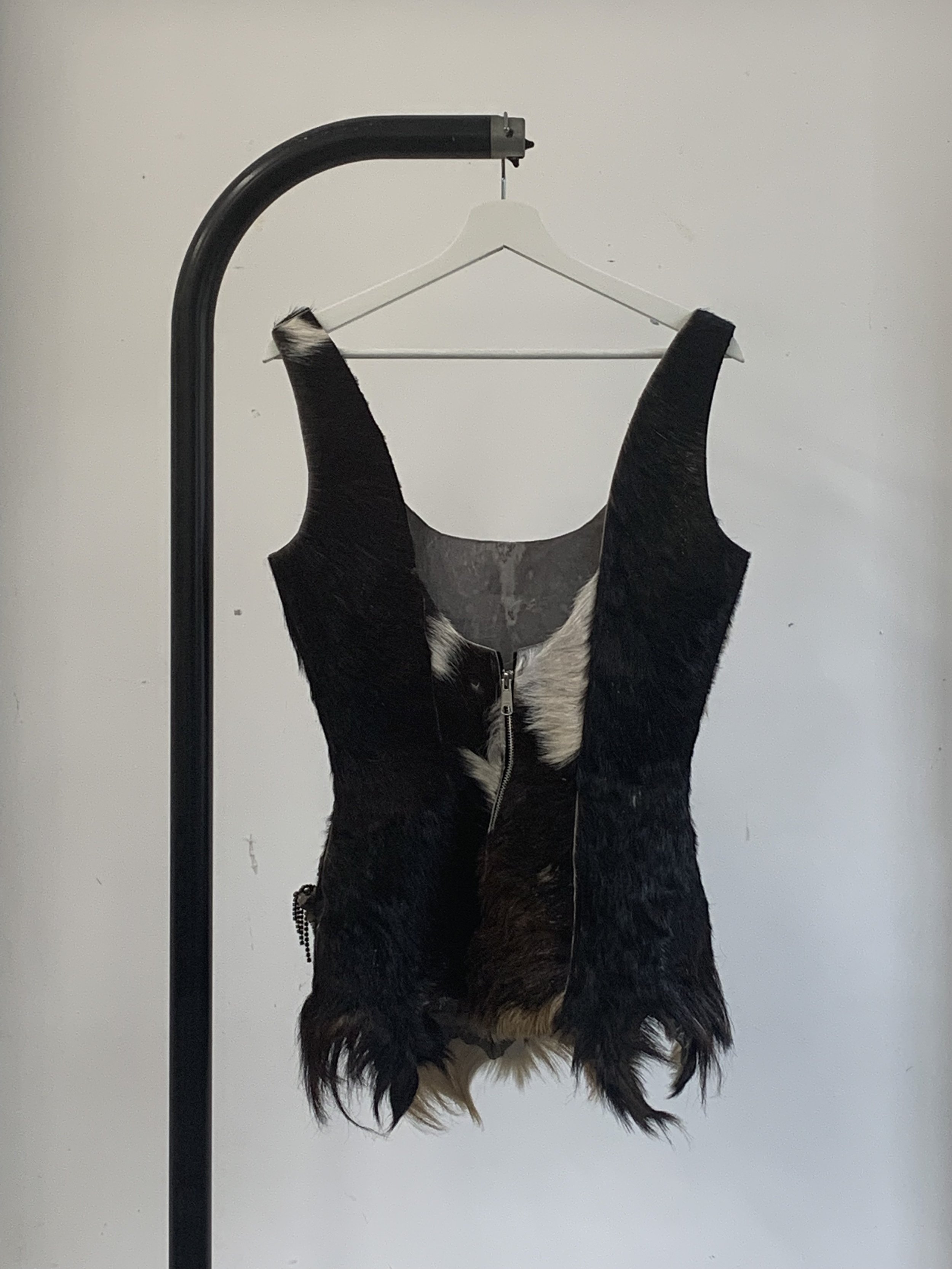
Primarily centred around the ideal of grotesque ornamentation, this bodice utilises degraded goat hide deemed unfit for commercial use. Recontextualised here in a tank style bodice to enhance its natural flaws, and subsequently shed a light on the perfectionism and waste generated by the rich and their desire for absolute aesthetic perfection. The bodice also features custom broach style embellishments made from vintage, jewellery and discarded animal bones, found on the shores of the thames, further reflecting that ideal of grotesque ornamentation.
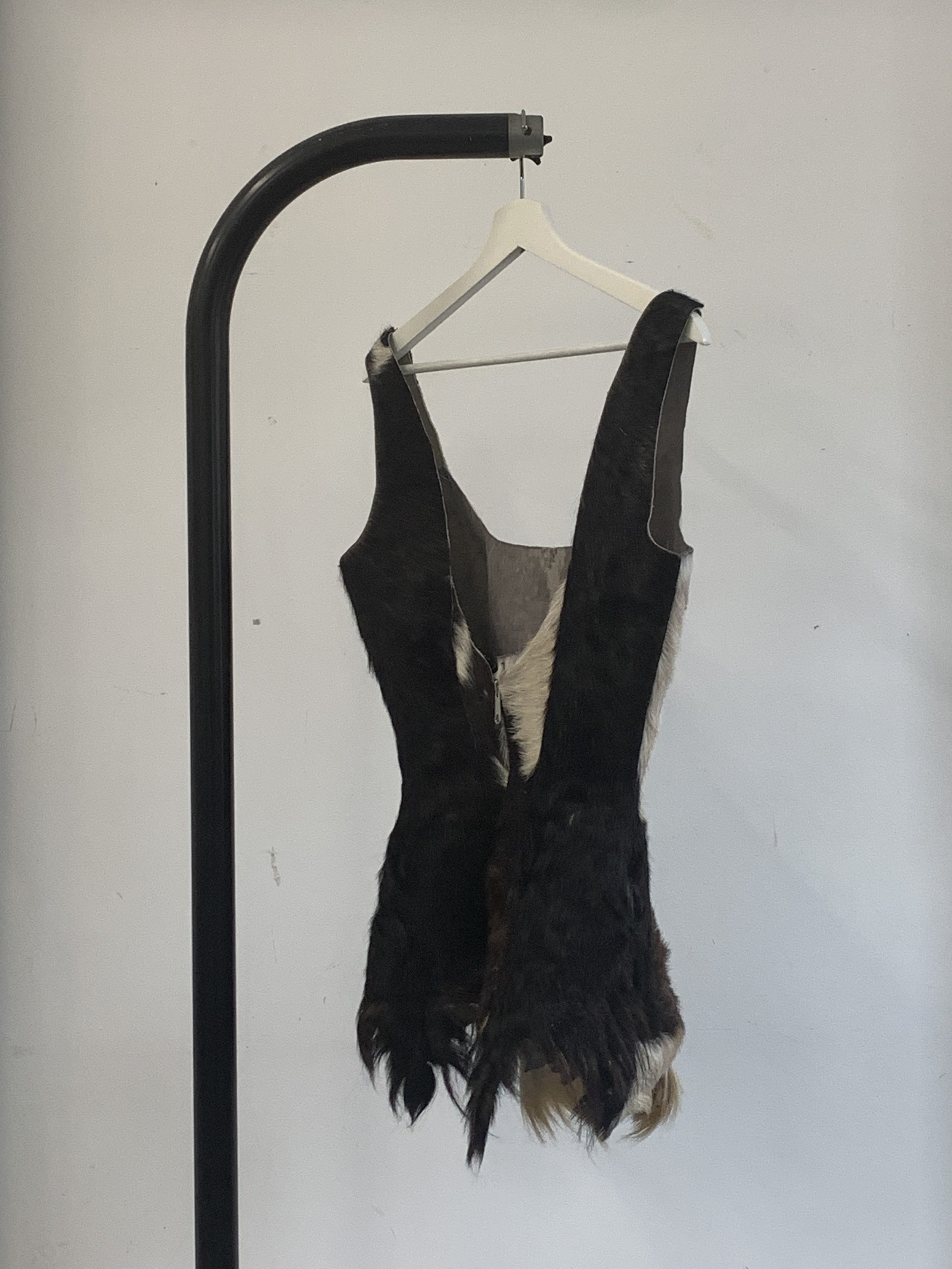
Primarily centred around the ideal of grotesque ornamentation, this bodice utilises degraded goat hide deemed unfit for commercial use. Recontextualised here in a tank style bodice to enhance its natural flaws, and subsequently shed a light on the perfectionism and waste generated by the rich and their desire for absolute aesthetic perfection. The bodice also features custom broach style embellishments made from vintage, jewellery and discarded animal bones, found on the shores of the thames, further reflecting that ideal of grotesque ornamentation.

Primarily centred around the ideal of grotesque ornamentation, this bodice utilises degraded goat hide deemed unfit for commercial use. Recontextualised here in a tank style bodice to enhance its natural flaws, and subsequently shed a light on the perfectionism and waste generated by the rich and their desire for absolute aesthetic perfection. The bodice also features custom broach style embellishments made from vintage, jewellery and discarded animal bones, found on the shores of the thames, further reflecting that ideal of grotesque ornamentation.
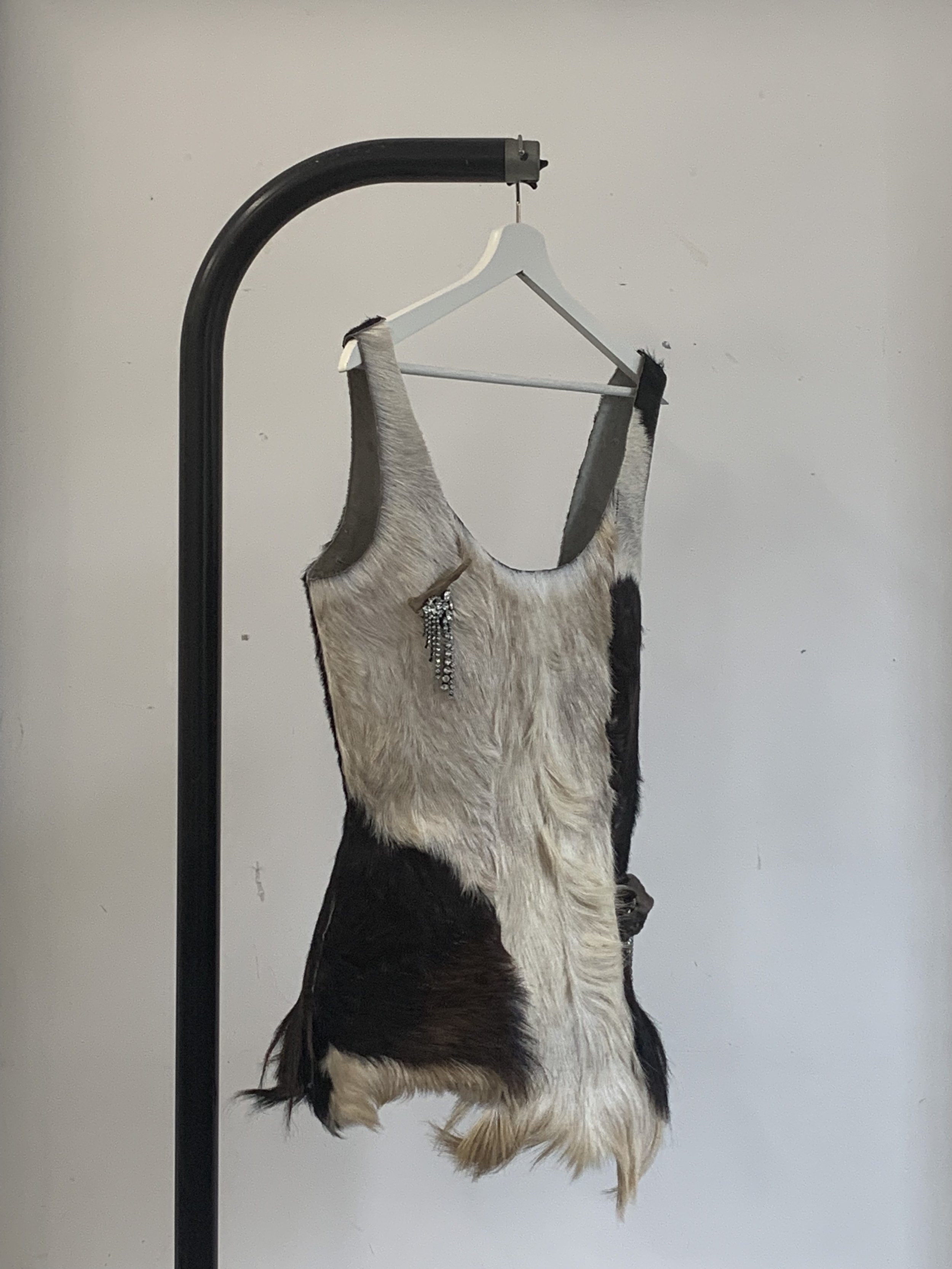
Primarily centred around the ideal of grotesque ornamentation, this bodice utilises degraded goat hide deemed unfit for commercial use. Recontextualised here in a tank style bodice to enhance its natural flaws, and subsequently shed a light on the perfectionism and waste generated by the rich and their desire for absolute aesthetic perfection. The bodice also features custom broach style embellishments made from vintage, jewellery and discarded animal bones, found on the shores of the thames, further reflecting that ideal of grotesque ornamentation.

Inspired by classical hunting attire, as well as the tactical nature of modern outdoor wear. This piece aims to reflect the dichotomy between the past and the present, reflecting the Aristocracies attachment to tradition and retaining of classist ideals. Rendered in a custom dyed and bleached cotton hand waxed to create the illusion of leather, this piece aims to reflect the fetishism of exotic animal hides within upper class circles i.e. big game trophy hunting. The colouring of the piece, A deep crimson bleeding into a forest green aims to reflect the trend of animal rights groups who famously poor paint, or blood, onto the fur coats and leather goods of the rich. In this garment, the faded red indicates the degradation of the piece, and the lack of upkeep that comes with a loss of financial power.

Inspired by classical hunting attire, as well as the tactical nature of modern outdoor wear. This piece aims to reflect the dichotomy between the past and the present, reflecting the Aristocracies attachment to tradition and retaining of classist ideals. Rendered in a custom dyed and bleached cotton hand waxed to create the illusion of leather, this piece aims to reflect the fetishism of exotic animal hides within upper class circles i.e. big game trophy hunting. The colouring of the piece, A deep crimson bleeding into a forest green aims to reflect the trend of animal rights groups who famously poor paint, or blood, onto the fur coats and leather goods of the rich. In this garment, the faded red indicates the degradation of the piece, and the lack of upkeep that comes with a loss of financial power.

Inspired by classical hunting attire, as well as the tactical nature of modern outdoor wear. This piece aims to reflect the dichotomy between the past and the present, reflecting the Aristocracies attachment to tradition and retaining of classist ideals. Rendered in a custom dyed and bleached cotton hand waxed to create the illusion of leather, this piece aims to reflect the fetishism of exotic animal hides within upper class circles i.e. big game trophy hunting. The colouring of the piece, A deep crimson bleeding into a forest green aims to reflect the trend of animal rights groups who famously poor paint, or blood, onto the fur coats and leather goods of the rich. In this garment, the faded red indicates the degradation of the piece, and the lack of upkeep that comes with a loss of financial power.

Inspired by classical hunting attire, as well as the tactical nature of modern outdoor wear. This piece aims to reflect the dichotomy between the past and the present, reflecting the Aristocracies attachment to tradition and retaining of classist ideals. Rendered in a custom dyed and bleached cotton hand waxed to create the illusion of leather, this piece aims to reflect the fetishism of exotic animal hides within upper class circles i.e. big game trophy hunting. The colouring of the piece, A deep crimson bleeding into a forest green aims to reflect the trend of animal rights groups who famously poor paint, or blood, onto the fur coats and leather goods of the rich. In this garment, the faded red indicates the degradation of the piece, and the lack of upkeep that comes with a loss of financial power.

Inspired by classical hunting attire, as well as the tactical nature of modern outdoor wear. This piece aims to reflect the dichotomy between the past and the present, reflecting the Aristocracies attachment to tradition and retaining of classist ideals. Rendered in a custom dyed and bleached cotton hand waxed to create the illusion of leather, this piece aims to reflect the fetishism of exotic animal hides within upper class circles i.e. big game trophy hunting. The colouring of the piece, A deep crimson bleeding into a forest green aims to reflect the trend of animal rights groups who famously poor paint, or blood, onto the fur coats and leather goods of the rich. In this garment, the faded red indicates the degradation of the piece, and the lack of upkeep that comes with a loss of financial power.
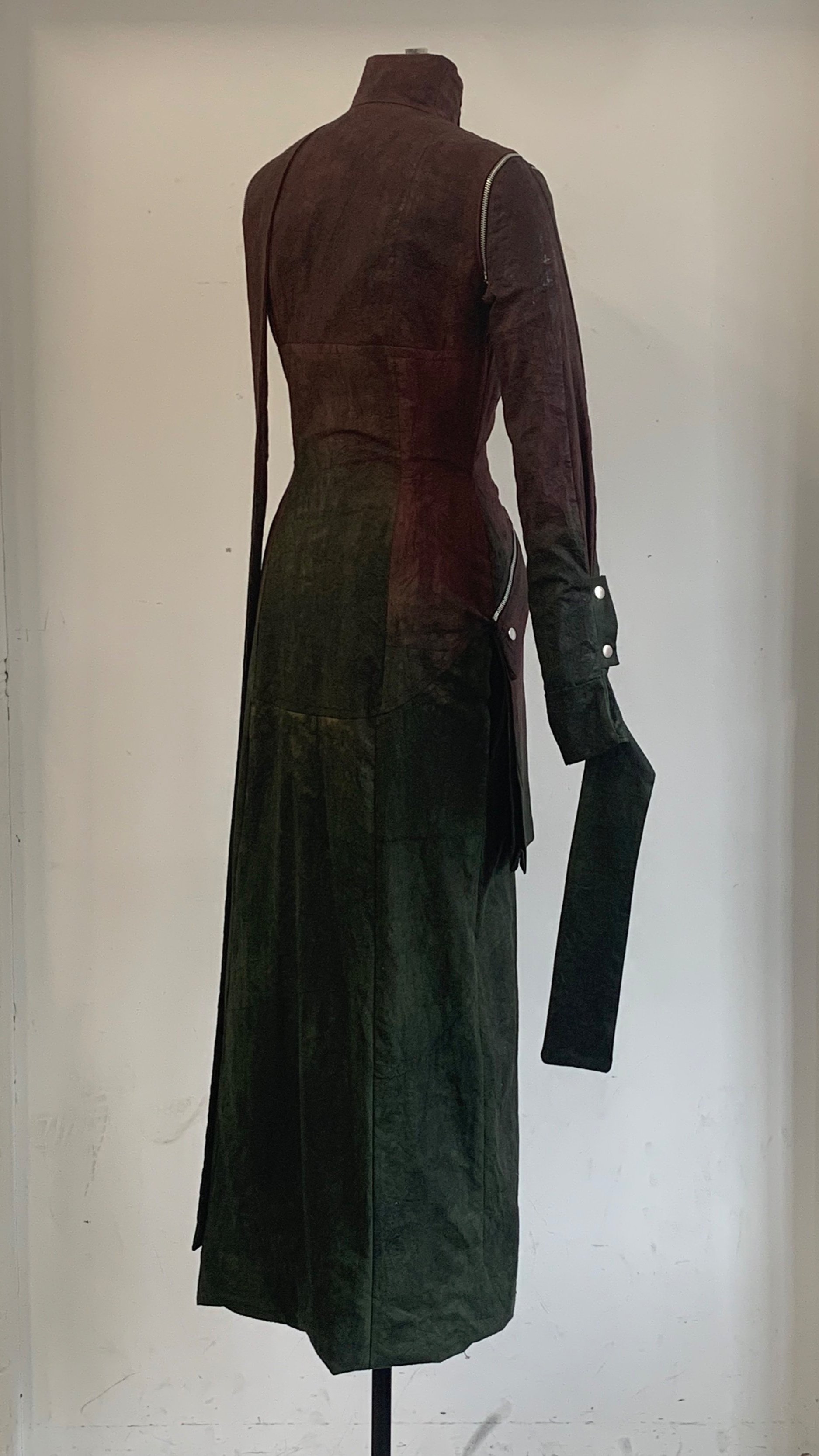
Inspired by classical hunting attire, as well as the tactical nature of modern outdoor wear. This piece aims to reflect the dichotomy between the past and the present, reflecting the Aristocracies attachment to tradition and retaining of classist ideals. Rendered in a custom dyed and bleached cotton hand waxed to create the illusion of leather, this piece aims to reflect the fetishism of exotic animal hides within upper class circles i.e. big game trophy hunting. The colouring of the piece, A deep crimson bleeding into a forest green aims to reflect the trend of animal rights groups who famously poor paint, or blood, onto the fur coats and leather goods of the rich. In this garment, the faded red indicates the degradation of the piece, and the lack of upkeep that comes with a loss of financial power.

Inspired by classical hunting attire, as well as the tactical nature of modern outdoor wear. This piece aims to reflect the dichotomy between the past and the present, reflecting the Aristocracies attachment to tradition and retaining of classist ideals. Rendered in a custom dyed and bleached cotton hand waxed to create the illusion of leather, this piece aims to reflect the fetishism of exotic animal hides within upper class circles i.e. big game trophy hunting. The colouring of the piece, A deep crimson bleeding into a forest green aims to reflect the trend of animal rights groups who famously poor paint, or blood, onto the fur coats and leather goods of the rich. In this garment, the faded red indicates the degradation of the piece, and the lack of upkeep that comes with a loss of financial power.

Inspired by classical hunting attire, as well as the tactical nature of modern outdoor wear. This piece aims to reflect the dichotomy between the past and the present, reflecting the Aristocracies attachment to tradition and retaining of classist ideals. Rendered in a custom dyed and bleached cotton hand waxed to create the illusion of leather, this piece aims to reflect the fetishism of exotic animal hides within upper class circles i.e. big game trophy hunting. The colouring of the piece, A deep crimson bleeding into a forest green aims to reflect the trend of animal rights groups who famously poor paint, or blood, onto the fur coats and leather goods of the rich. In this garment, the faded red indicates the degradation of the piece, and the lack of upkeep that comes with a loss of financial power.
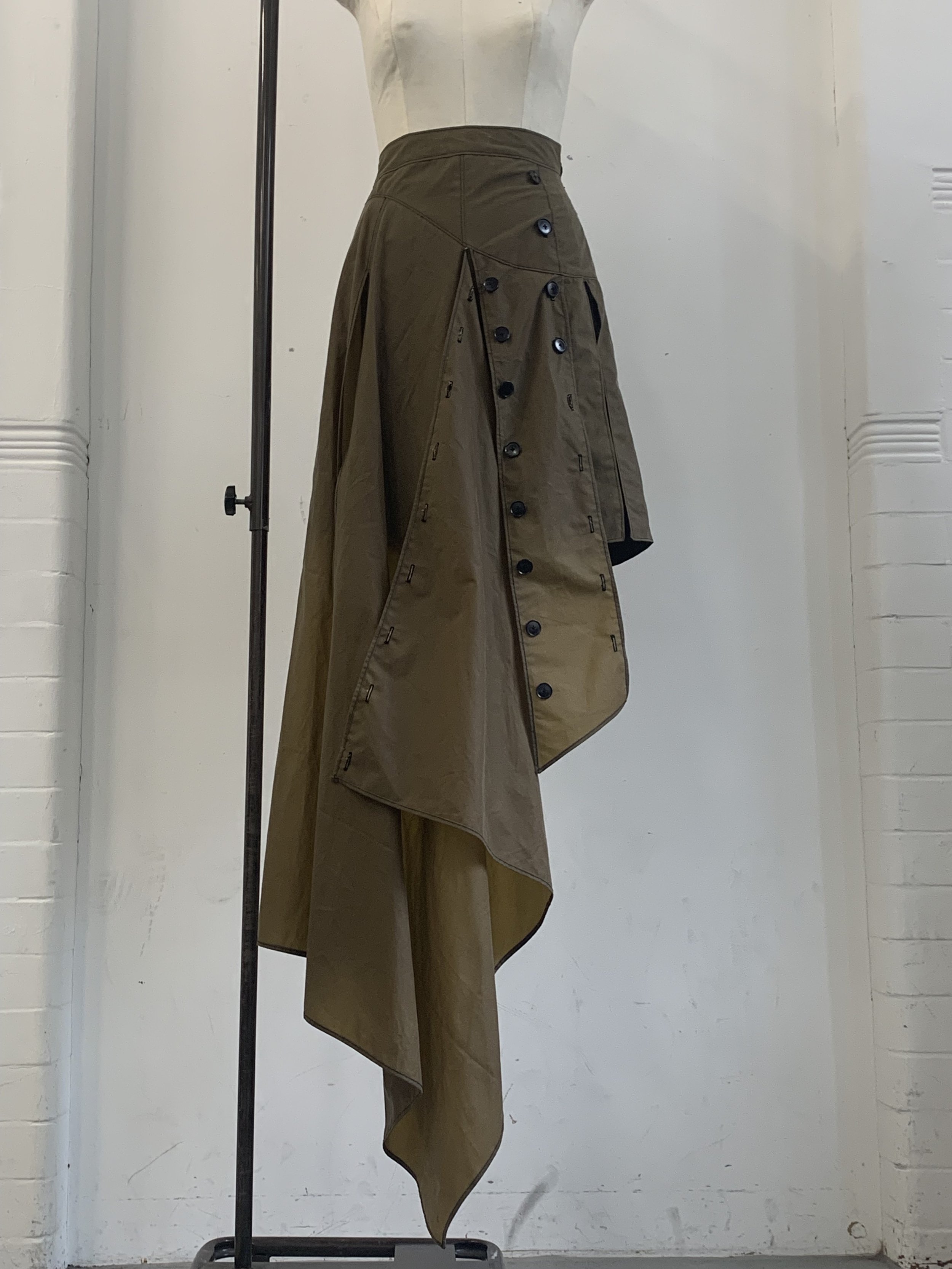
Drawing on my research into the feminine attire of historical hunting clothing, i.e. the riding habit, this piece aims to blur the lines between the masculine and feminine by utilising and morphing two predominantly gendered pieces, the skirt and the Bermuda short, into one piece. Able to be morphed and adapted for multiple outdoor and interior settings, This piece reflects the adaptability of the collection as a unit.
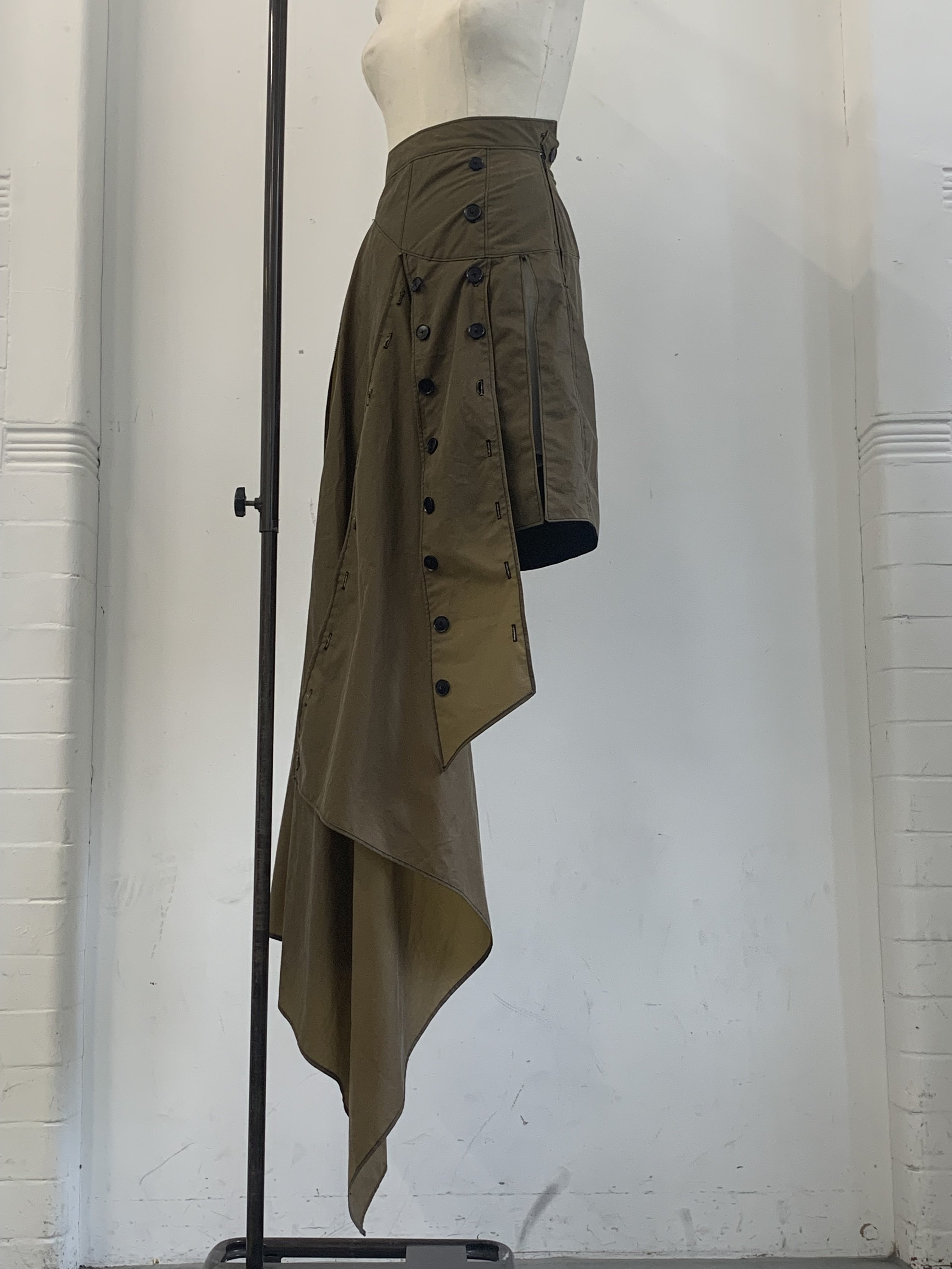
Drawing on my research into the feminine attire of historical hunting clothing, i.e. the riding habit, this piece aims to blur the lines between the masculine and feminine by utilising and morphing two predominantly gendered pieces, the skirt and the Bermuda short, into one piece. Able to be morphed and adapted for multiple outdoor and interior settings, This piece reflects the adaptability of the collection as a unit.
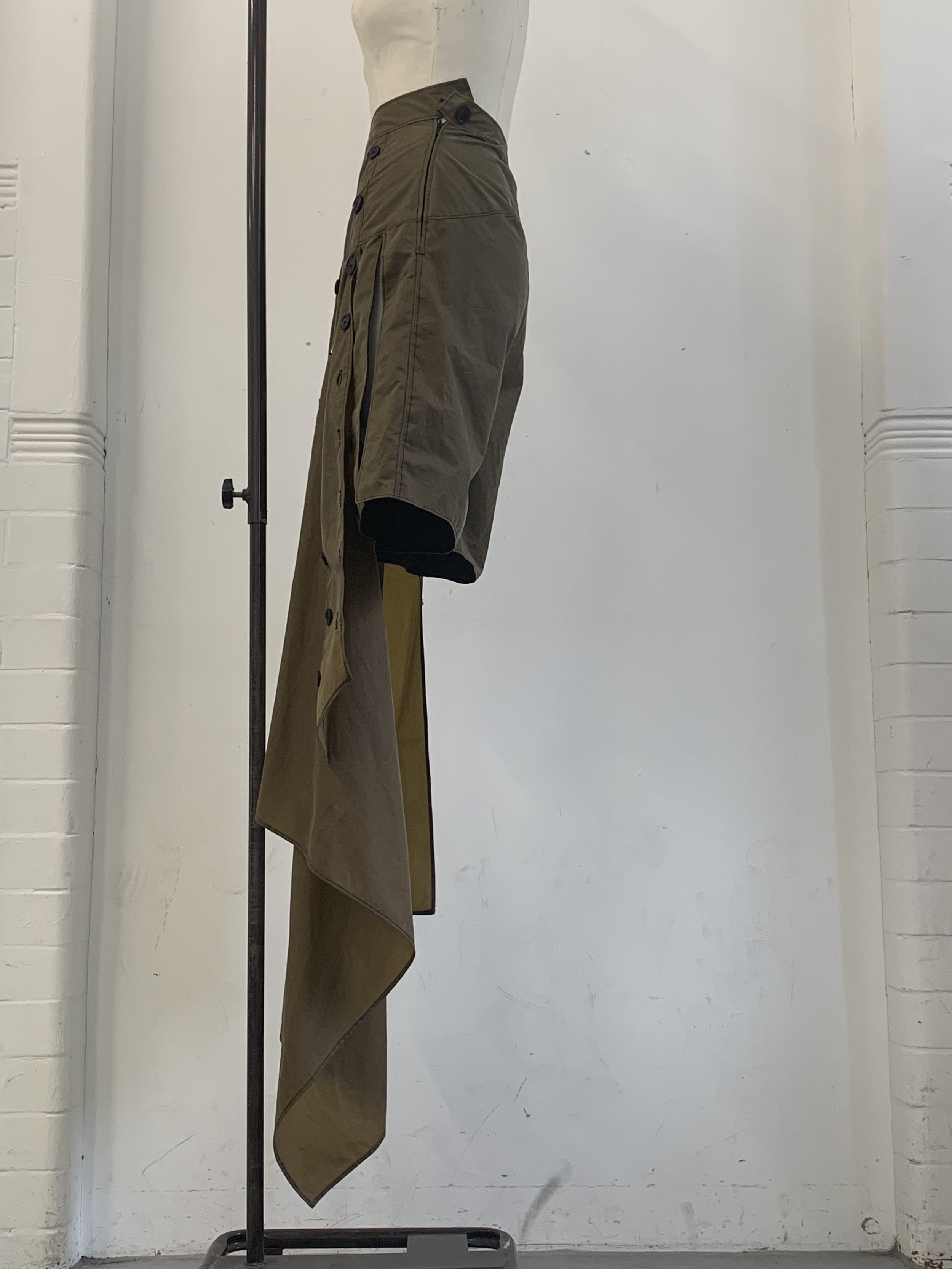
Drawing on my research into the feminine attire of historical hunting clothing, i.e. the riding habit, this piece aims to blur the lines between the masculine and feminine by utilising and morphing two predominantly gendered pieces, the skirt and the Bermuda short, into one piece. Able to be morphed and adapted for multiple outdoor and interior settings, This piece reflects the adaptability of the collection as a unit.
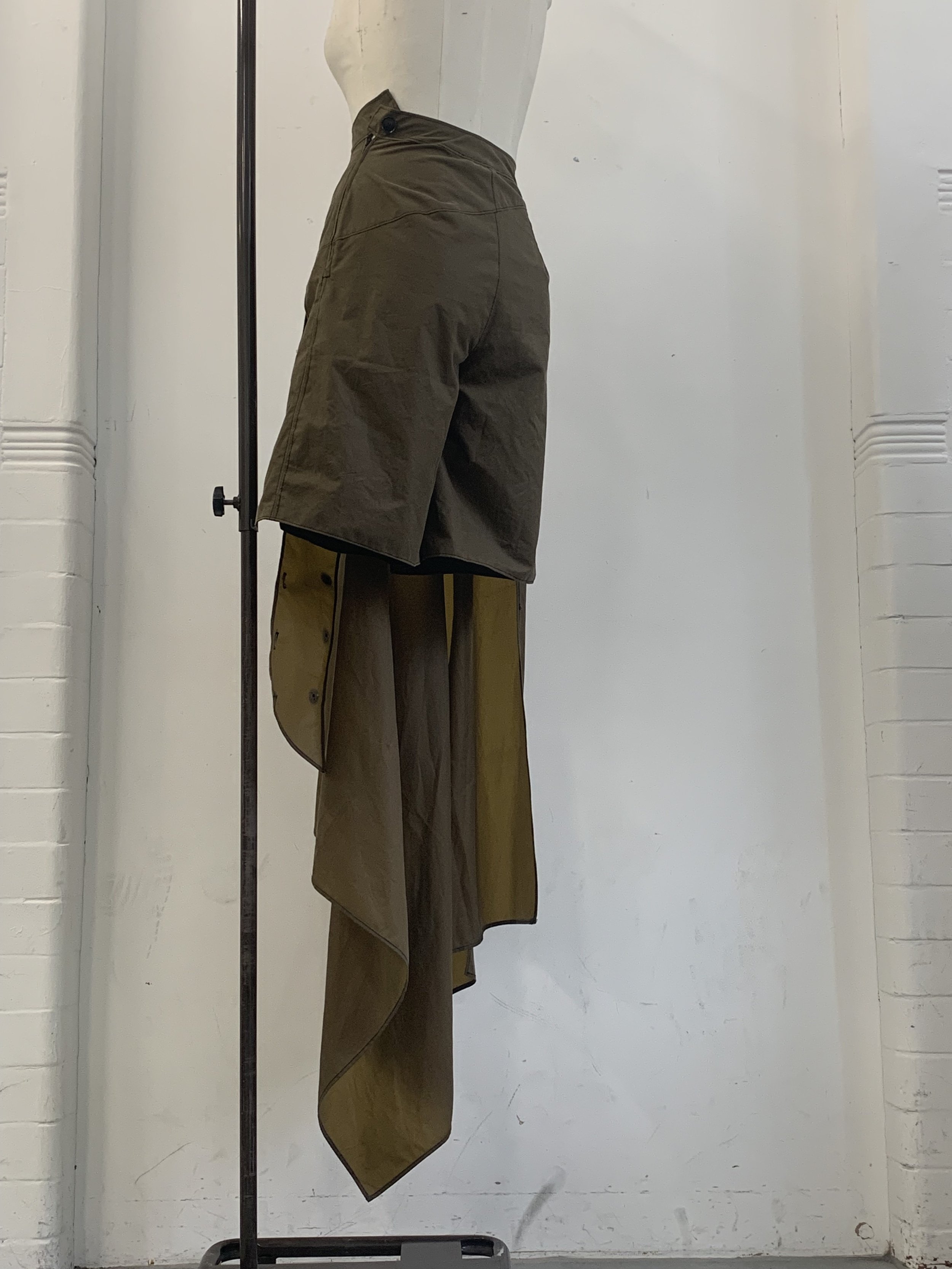
Drawing on my research into the feminine attire of historical hunting clothing, i.e. the riding habit, this piece aims to blur the lines between the masculine and feminine by utilising and morphing two predominantly gendered pieces, the skirt and the Bermuda short, into one piece. Able to be morphed and adapted for multiple outdoor and interior settings, This piece reflects the adaptability of the collection as a unit.
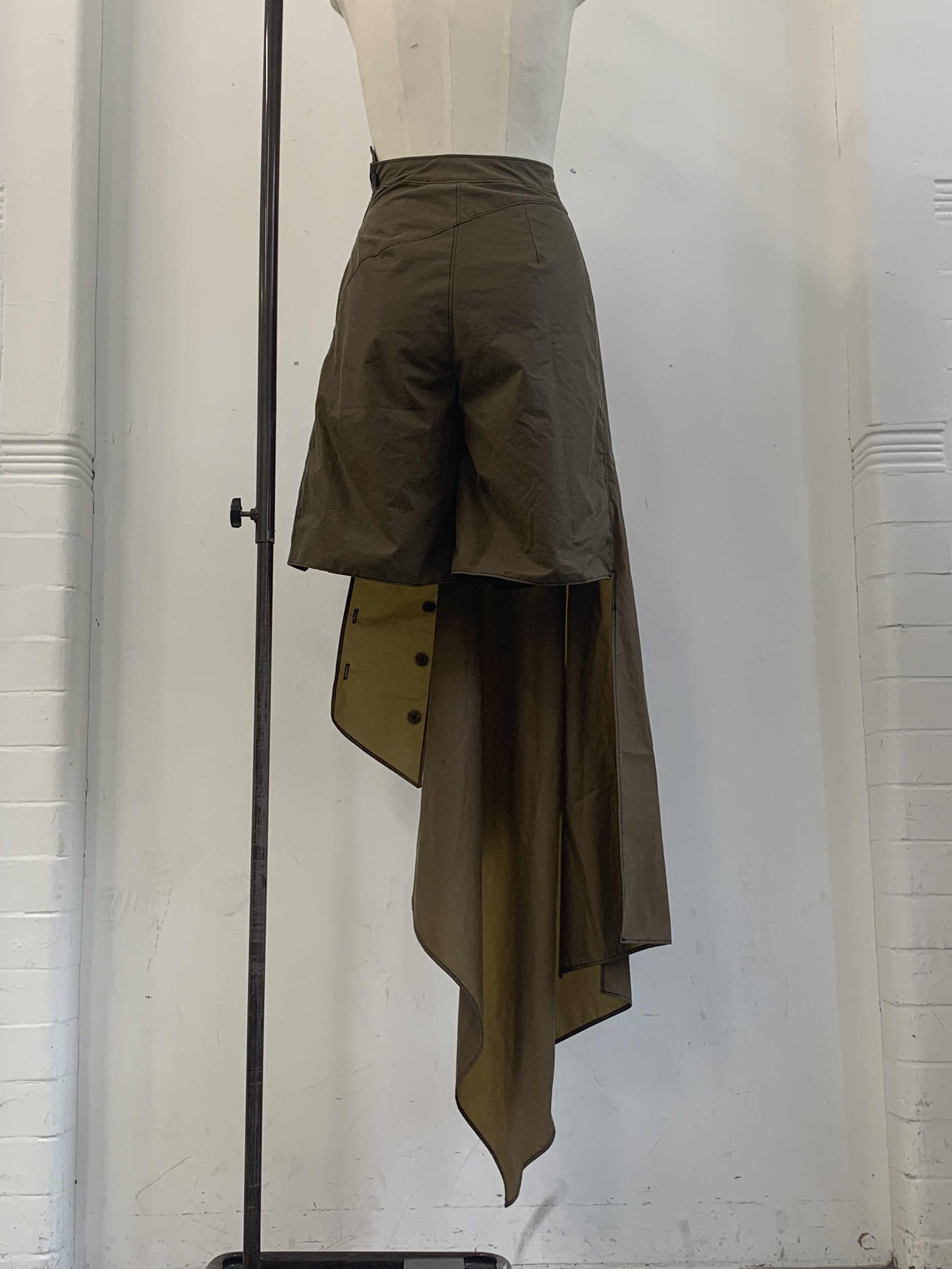
Drawing on my research into the feminine attire of historical hunting clothing, i.e. the riding habit, this piece aims to blur the lines between the masculine and feminine by utilising and morphing two predominantly gendered pieces, the skirt and the Bermuda short, into one piece. Able to be morphed and adapted for multiple outdoor and interior settings, This piece reflects the adaptability of the collection as a unit.
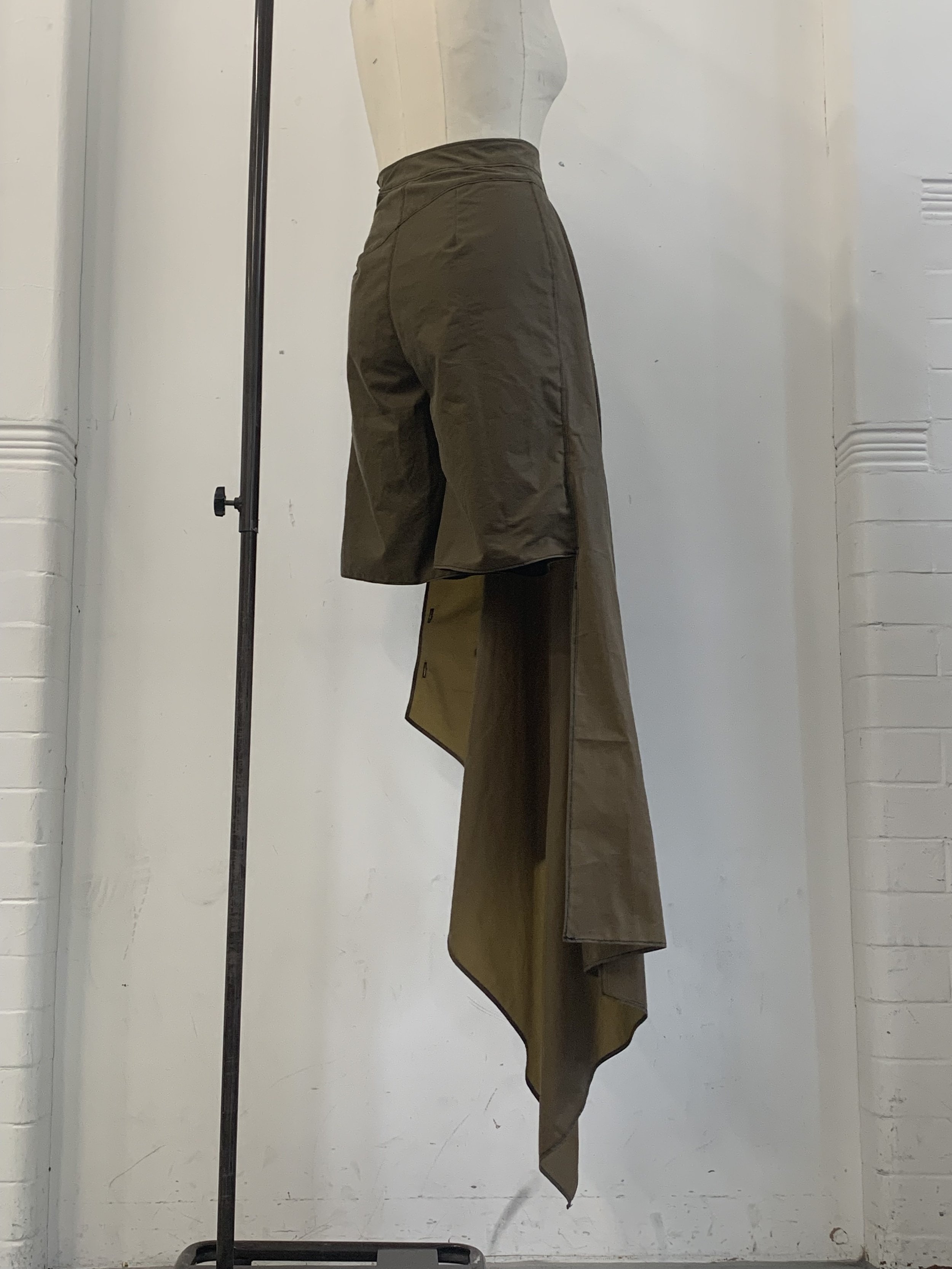
Drawing on my research into the feminine attire of historical hunting clothing, i.e. the riding habit, this piece aims to blur the lines between the masculine and feminine by utilising and morphing two predominantly gendered pieces, the skirt and the Bermuda short, into one piece. Able to be morphed and adapted for multiple outdoor and interior settings, This piece reflects the adaptability of the collection as a unit.
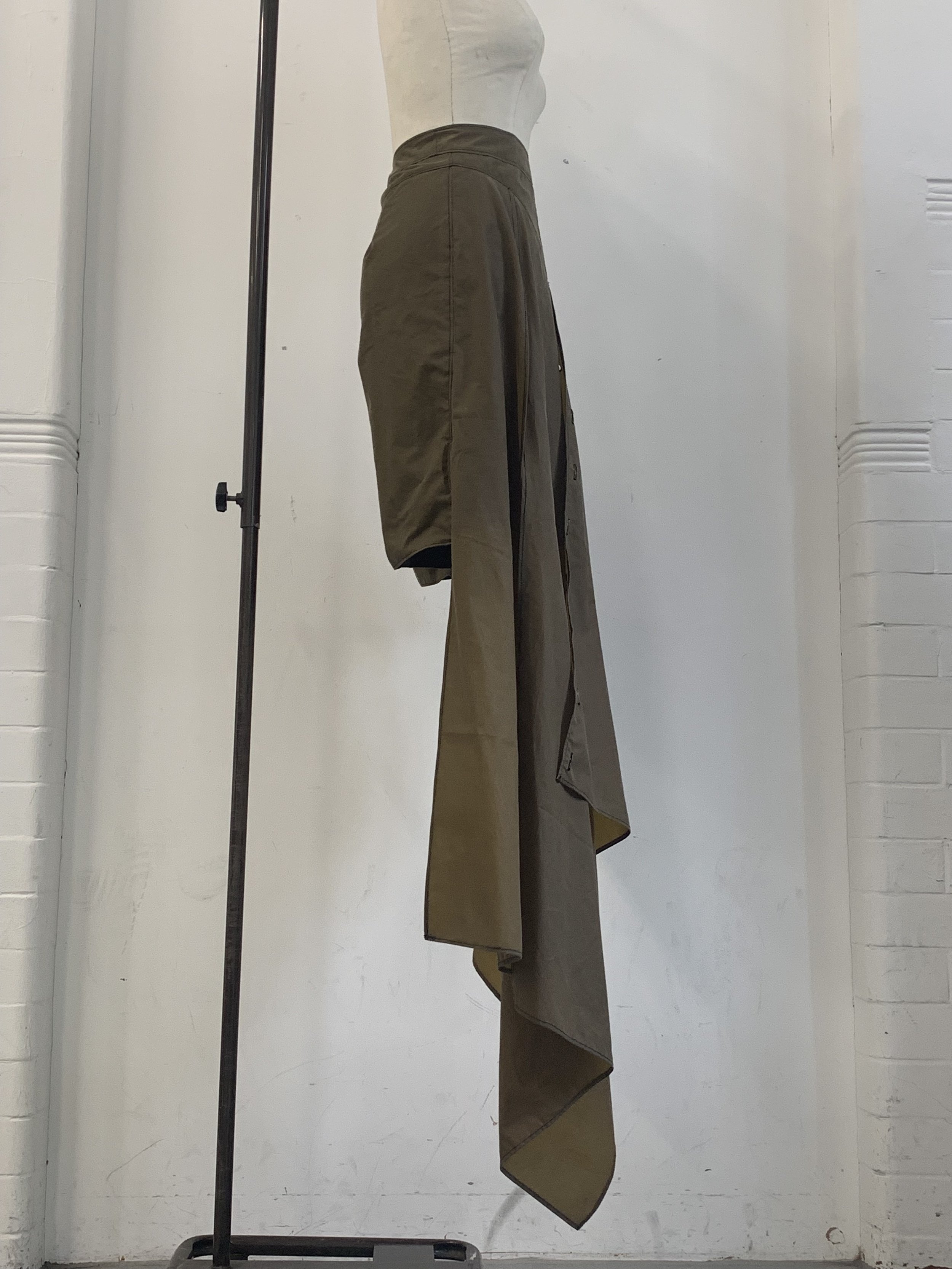
Drawing on my research into the feminine attire of historical hunting clothing, i.e. the riding habit, this piece aims to blur the lines between the masculine and feminine by utilising and morphing two predominantly gendered pieces, the skirt and the Bermuda short, into one piece. Able to be morphed and adapted for multiple outdoor and interior settings, This piece reflects the adaptability of the collection as a unit.
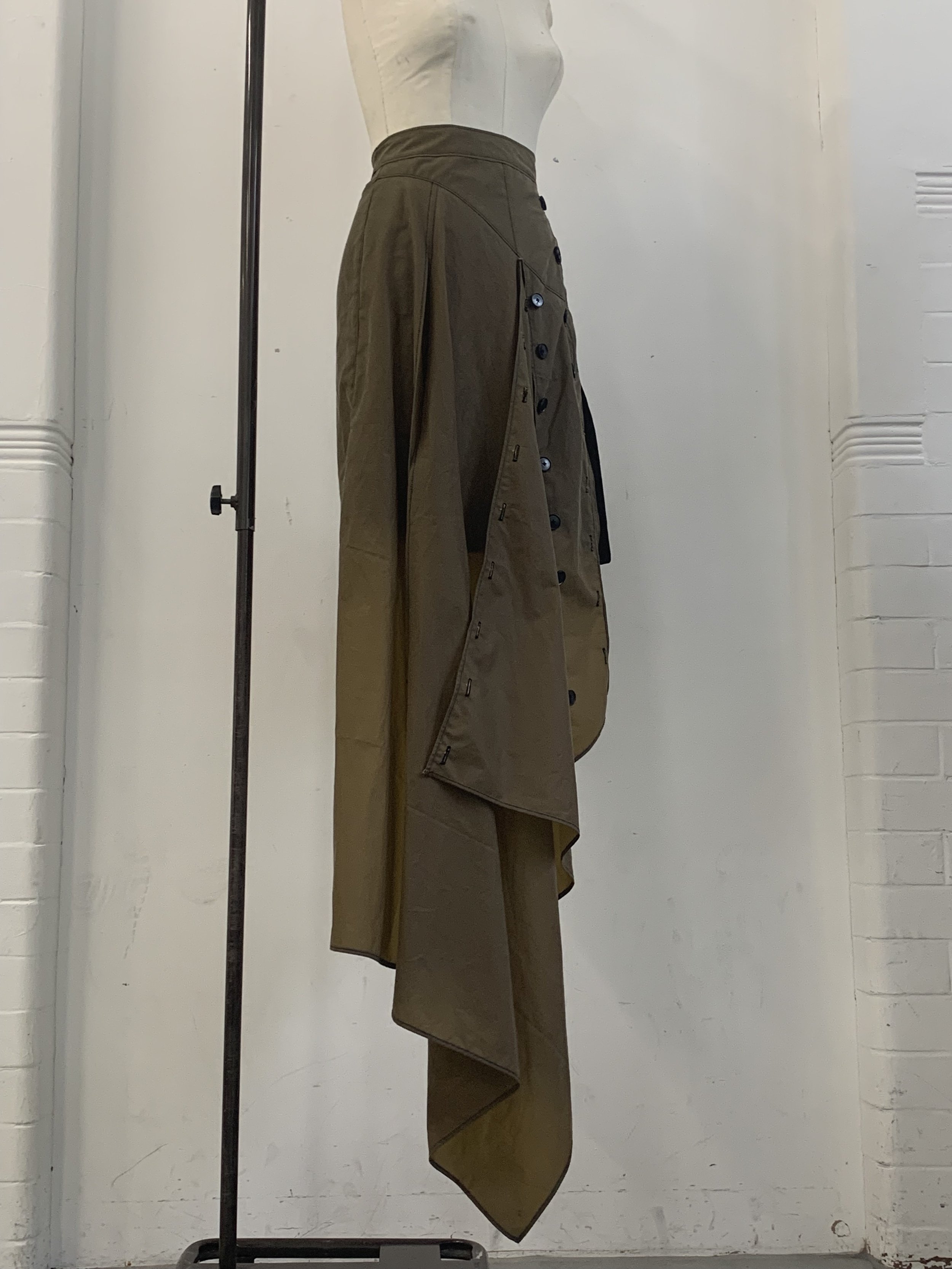
Drawing on my research into the feminine attire of historical hunting clothing, i.e. the riding habit, this piece aims to blur the lines between the masculine and feminine by utilising and morphing two predominantly gendered pieces, the skirt and the Bermuda short, into one piece. Able to be morphed and adapted for multiple outdoor and interior settings, This piece reflects the adaptability of the collection as a unit.















